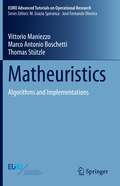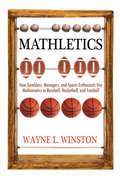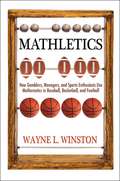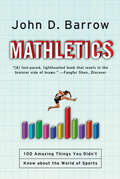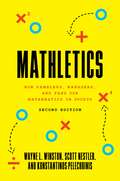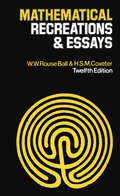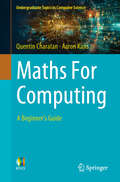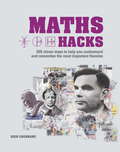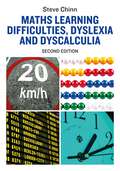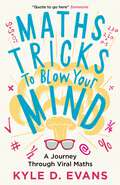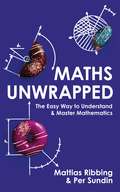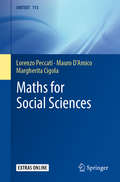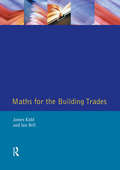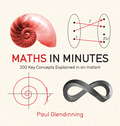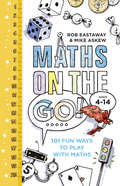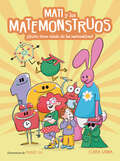- Table View
- List View
Matheuristics: Algorithms and Implementations (EURO Advanced Tutorials on Operational Research)
by Thomas Stützle Vittorio Maniezzo Marco Antonio BoschettiThis book is the first comprehensive tutorial on matheuristics. Matheuristics are based on mathematical extensions of previously known heuristics, mainly metaheuristics, and on original, area-specific approaches. This tutorial provides a detailed discussion of both contributions, presenting the pseudocodes of over 40 algorithms, abundant literature references, and for each case a step-by-step description of a sample run on a common Generalized Assignment Problem example. C++ source codes of all algorithms are available in an associated SW repository.
Mathletics
by Wayne L. WinstonMathletics is a remarkably entertaining book that shows readers how to use simple mathematics to analyze a range of statistical and probability-related questions in professional baseball, basketball, and football, and in sports gambling. How does professional baseball evaluate hitters? Is a singles hitter like Wade Boggs more valuable than a power hitter like David Ortiz? Should NFL teams pass or run more often on first downs? Could professional basketball have used statistics to expose the crooked referee Tim Donaghy? Does money buy performance in professional sports? In Mathletics, Wayne Winston describes the mathematical methods that top coaches and managers use to evaluate players and improve team performance, and gives math enthusiasts the practical tools they need to enhance their understanding and enjoyment of their favorite sports--and maybe even gain the outside edge to winning bets. Mathletics blends fun math problems with sports stories of actual games, teams, and players, along with personal anecdotes from Winston's work as a sports consultant. Winston uses easy-to-read tables and illustrations to illuminate the techniques and ideas he presents, and all the necessary math concepts--such as arithmetic, basic statistics and probability, and Monte Carlo simulations--are fully explained in the examples. After reading Mathletics, you will understand why baseball teams should almost never bunt, why football overtime systems are unfair, why points, rebounds, and assists aren't enough to determine who's the NBA's best player--and much, much more. In a new epilogue, Winston discusses the stats and numerical analysis behind some recent sporting events, such as how the Dallas Mavericks used analytics to become the 2011 NBA champions.
Mathletics
by Wayne WinstonMathleticsis a remarkably entertaining book that shows readers how to use simple mathematics to analyze a range of statistical and probability-related questions in professional baseball, basketball, and football, and in sports gambling. How does professional baseball evaluate hitters? Is a singles hitter like Wade Boggs more valuable than a power hitter like David Ortiz? Should NFL teams pass or run more often on first downs? Could professional basketball have used statistics to expose the crooked referee Tim Donaghy? Does money buy performance in professional sports?InMathletics, Wayne Winston describes the mathematical methods that top coaches and managers use to evaluate players and improve team performance, and gives math enthusiasts the practical tools they need to enhance their understanding and enjoyment of their favorite sports--and maybe even gain the outside edge to winning bets. Mathleticsblends fun math problems with sports stories of actual games, teams, and players, along with personal anecdotes from Winston's work as a sports consultant. Winston uses easy-to-read tables and illustrations to illuminate the techniques and ideas he presents, and all the necessary math concepts--such as arithmetic, basic statistics and probability, and Monte Carlo simulations--are fully explained in the examples. After readingMathletics, you will understand why baseball teams should almost never bunt, why football overtime systems are unfair, why points, rebounds, and assists aren't enough to determine who's the NBA's best player--and much, much more.
Mathletics: 100 Amazing Things You Didn't Know about the World of Sports
by John D. BarrowAn entertaining, eye-opening guide to what math and physics can reveal about sports. How can sprinter Usain Bolt break his world record without expending any additional effort? What dates of birth give rise to the best professional athletes? Is it better to have the inside or outside lane during a race? Drawing on vivid, real-life examples, mathematician John D. Barrow entertainingly explores the eye-opening, often counterintuitive, insights into the world of sports that math and physics can give us. For example, we learn that left-handed boxers have a statistical advantage over their right-handed opponents. Through clear, detailed, and fascinating mathematical explanations, Barrow reveals the best techniques and strategies for an incredible range of sports, from soccer and running to cycling, archery, gymnastics, and rowing.
Mathletics: How Gamblers, Managers, and Fans Use Mathematics in Sports, Second Edition
by Wayne L. Winston Konstantinos Pelechrinis Scott NestlerHow to use math to improve performance and predict outcomes in professional sportsMathletics reveals the mathematical methods top coaches and managers use to evaluate players and improve team performance, and gives math enthusiasts the practical skills they need to enhance their understanding and enjoyment of their favorite sports—and maybe even gain the outside edge to winning bets. This second edition features new data, new players and teams, and new chapters on soccer, e-sports, golf, volleyball, gambling Calcuttas, analysis of camera data, Bayesian inference, ridge regression, and other statistical techniques. After reading Mathletics, you will understand why baseball teams should almost never bunt; why football overtime systems are unfair; why points, rebounds, and assists aren’t enough to determine who’s the NBA’s best player; and more.
Mathmatical Recreations & Essays (12th Edition)
by H.S.M. Coxeter W. W. BallFor over eighty years this delightful classic has provided entertainment through mathematical problems commonly known as recreations. Although they often involve fundamental mathematical methods and notions, their chief appeal is as games or puzzles rather than the usefulness of their conclusions. This new edition upholds the original, but the terminology and treatment of problems have been updated and much new material has been added. There are new selections on polyominoes and the notion of dragon designs, and a new chapter, 'Introduction to Combinatorics.' Other topics dealt with in the fourteen chapters include arithmetical and geometrical recreations and problems, polyhedra, chess-board recreations, unicursal problems, cryptography and cryptanalysis, and calculating prodigies. Since no knowledge of calculus or analytic geometry is necessary to enjoy the recreations, this book will appeal widely to teachers of mathematics and students and to anyone who is mathematically inclined.
Maths 1001: Absolutely Everything That Matters in Mathematics
by Richard Elwes Dr Richard ElwesThe ultimate smart reference to the world of mathematics - from quadratic equations and Pythagoras' Theorem to chaos theory and quantum computing.Maths 1001 provides clear and concise explanations of the most fascinating and fundamental mathematical concepts. Distilled into 1001 bite-sized mini-essays arranged thematically, this unique reference book moves steadily from the basics through to the most advanced of ideas, making it the ideal guide for novices and mathematics enthusiasts. Whether used as a handy reference, an informal self-study course or simply as a gratifying dip-in, this book offers - in one volume - a world of mathematical knowledge for the general reader. Maths 1001 is an incredibly comprehensive guide, spanning all of the key mathematical fields including Numbers, Geometry, Algebra, Analysis, Discrete Mathematics, Logic and the Philosophy of Maths, Applied Mathematics, Statistics and Probability and Puzzles and Mathematical Games. From zero and infinity to relativity and Godel's proof that maths is incomplete, Dr Richard Elwes explains the key concepts of mathematics in the simplest language with a minimum of jargon. Along the way he reveals mathematical secrets such as how to count to 1023 using just 10 fingers and how to make an unbreakable code, as well as answering such questions as: Are imaginary numbers real? How can something be both true and false? Why is it impossible to draw an accurate map of the world? And how do you get your head round the mind-bending Monty Hall problem? Extensive, enlightening and entertaining, this really is the only maths book anyone would ever need to buy.
Maths 1001: Absolutely Everything That Matters in Mathematics
by Richard Elwes Dr Richard ElwesThe ultimate smart reference to the world of mathematics - from quadratic equations and Pythagoras' Theorem to chaos theory and quantum computing.Maths 1001 provides clear and concise explanations of the most fascinating and fundamental mathematical concepts. Distilled into 1001 bite-sized mini-essays arranged thematically, this unique reference book moves steadily from the basics through to the most advanced of ideas, making it the ideal guide for novices and mathematics enthusiasts. Whether used as a handy reference, an informal self-study course or simply as a gratifying dip-in, this book offers - in one volume - a world of mathematical knowledge for the general reader. Maths 1001 is an incredibly comprehensive guide, spanning all of the key mathematical fields including Numbers, Geometry, Algebra, Analysis, Discrete Mathematics, Logic and the Philosophy of Maths, Applied Mathematics, Statistics and Probability and Puzzles and Mathematical Games. From zero and infinity to relativity and Godel's proof that maths is incomplete, Dr Richard Elwes explains the key concepts of mathematics in the simplest language with a minimum of jargon. Along the way he reveals mathematical secrets such as how to count to 1023 using just 10 fingers and how to make an unbreakable code, as well as answering such questions as: Are imaginary numbers real? How can something be both true and false? Why is it impossible to draw an accurate map of the world? And how do you get your head round the mind-bending Monty Hall problem? Extensive, enlightening and entertaining, this really is the only maths book anyone would ever need to buy.
Maths For Computing: A Beginner's Guide (Undergraduate Topics in Computer Science)
by Quentin Charatan Aaron KansThis introductory textbook covers all the mathematical concepts necessary for a computing degree, limiting coverage only to the material needed for the fundamentals of computing rather than delving into the higher mathematical concepts. Key features include: Gears content toward students who are less confident in mathematics Provides exercises, with solutions, at the end of each chapter Teaches topics using everyday language Includes numerous worked examples in every chapter Uses familiar scenarios to introduce mathematical concepts Discusses the relevance of each chapter topic to the world of computing Core topics covered include: Set and groups Matrices Relations and functions Logic and proofs Combinatorics Probability Graph theory The book is written for students embarking on an undergraduate or foundation degree course in computer science (or related discipline) and aims to provide the basic skills and knowledge of discrete mathematics required for such a course. Whereas many textbooks tend to teach this subject in a way that is more suitable for mathematicians, this text specifically targets first-year students on computing courses and aims to teach only the basic material that they will need for their computing degree. Dr Quentin Charatan is a former Principal Lecturer and now visiting lecturer at the University of East London, UK. Dr Aaron Kans is the Head of the Computer Science and Digital Technologies Department in the School of Architecture, Computing & Engineering at the same institution.
Maths Hacks
by Richard CochraneEverything you need to know about 100 key mathematical concepts condensed into easy-to-understand sound bites designed to stick in your memory and give you an instant grasp of the concept.On each topic, you'll start with a helicopter overview of the subject, which will give you an introduction to the idea and some context surrounding it. Next, you'll zoom in on the core elements of the theory, with clear explanation of each point to make sure you really understand the concept, along with simple examples that everyone can follow. Finally, you'll be given a one-liner hack to really make the theory stick in your mind. The perfect introduction to algebra, logic, probability and much more, this is a great new way to learn about the most important mathematical ideas and concepts in a way that makes them easy to recall even months after reading the book.Topics covered include:NumbersAlgebraLogicGeometryProbabilityComputer scienceApplied mathematicsMechanicsStatisticsSet Theory
Maths Hacks (Hacks)
by Richard CochraneEverything you need to know about 100 key mathematical concepts condensed into easy-to-understand sound bites designed to stick in your memory and give you an instant grasp of the concept.On each topic, you'll start with a helicopter overview of the subject, which will give you an introduction to the idea and some context surrounding it. Next, you'll zoom in on the core elements of the theory, with clear explanation of each point to make sure you really understand the concept, along with simple examples that everyone can follow. Finally, you'll be given a one-liner hack to really make the theory stick in your mind. The perfect introduction to algebra, logic, probability and much more, this is a great new way to learn about the most important mathematical ideas and concepts in a way that makes them easy to recall even months after reading the book.Topics covered include:NumbersAlgebraLogicGeometryProbabilityComputer scienceApplied mathematicsMechanicsStatisticsSet Theory
Maths Homework for Key Stage 2: Activity-Based Learning (Active Homework)
by Colin Forster Vicki Parfitt Andrea McGowanMaths Homework for Key Stage 2 is a unique resource for busy teachers – a selection of ‘pencil-free’, hands-on activities that teachers can use as extension activities or give to pupils as homework to do with members of their family or friends. Each of the activities encourages the pupils to learn through discussion and through practical activities utilising everyday resources. Each activity is quick and easy for pupils and teachers to manage, and includes: a learning aim full, clear instructions and discussion points tasks to develop collaboration and partnership between pupils, parents and teachers photocopiable resources. A refreshing approach for teachers and pupils, these activities will foster enthusiasm for learning and inspire pupils' interest in Maths.
Maths Learning Difficulties, Dyslexia and Dyscalculia: Second Edition (Dyslexia Essentials Ser.)
by Steve ChinnWritten by a world authority on maths difficulties in children, this accessible guide provides tried and tested visual strategies and tailored techniques to help teachers and parents support children with SpLDs who need help with maths.Drawing on the latest research, into areas such as cognition and meta-cognition, along with the authors' decades of teaching experience, the book offers insight into how maths learning difficulties, including dyslexia, dyscalculia and maths anxiety, make maths difficult. Each chapter looks at foundational areas of maths learning that children may struggle with, from early number experiences to basic addition and subtraction, times tables, measurement and more. Essential reading for any teacher, learning assistant or parent supporting children with maths.
Maths Magic class 1 - Andhra Pradesh Board
by State Council of Educational Research and Training Andhra PradeshThis book has 9 chapters. Narrate the stories and answer the questions. Children focus on Rhymes andExercises.
Maths Mela class 3 - NCERT-25
by National Council of Educational Research and TrainingThe Maths Mela textbook for Class 3, developed by NCERT under the National Education Policy 2020 and the National Curriculum Framework for School Education 2023, is a thoughtfully designed resource that blends foundational mathematics with engaging activities. The book aims to develop children's conceptual understanding, problem-solving skills, and mathematical thinking through a joyful, inclusive, and discovery-based approach. It covers key topics such as numbers and operations, shapes and spatial understanding, measurement, data handling, and early fractions. Emphasis is placed on experiential learning with the help of puzzles, games, storytelling, group activities, and visual aids like illustrations and manipulatives. Special sections like "Let us Do," "Let us Think," and "Let us Play" make abstract concepts tangible and promote self-exploration. The textbook also supports diverse learning needs through adaptive assessments and encourages peer discussion to enhance critical thinking. The content integrates cultural relevance, gender sensitivity, and multilingualism while gradually transitioning learners from concrete to abstract reasoning. Designed to create a fear-free and stimulating environment, Maths Mela fosters not just academic growth but also a genuine curiosity and love for mathematics, making it an ideal tool for both classroom learning and home reinforcement.
Maths Mela class 5 - NCERT - 25
by National Council of Educational Research and TrainingMaths Mela – Textbook of Mathematics for Grade 5 is an engaging NCERT publication designed in accordance with the National Education Policy 2020 and the National Curriculum Framework for School Education 2023. The book consolidates the foundational concepts of mathematics while introducing children to more abstract ideas in a joyful and stress-free manner. It covers essential topics such as whole numbers, fractions, shapes and patterns, measurement of length, weight, capacity, time, angles, symmetry, data handling, and problem-solving through real-life contexts. Each chapter is enriched with activities, games, puzzles, and stories that spark curiosity and promote critical thinking, reasoning, and creativity. Sections like Let Us Do, Let Us Think, and Let Us Explore encourage hands-on exploration, peer learning, and logical reasoning, while puzzles and mathematical games nurture computational thinking. The textbook gradually builds complexity, ensuring that children develop arithmetic fluency, spatial understanding, and problem-solving strategies without relying on rote memorisation. Vivid illustrations and relatable examples connect mathematics with everyday experiences, making learning meaningful and enjoyable. Teachers and parents are guided to use simple, inexpensive materials and discussions to foster independent thinking, communication, and collaborative learning. Ultimately, Maths Mela aims to instill confidence, curiosity, and a lifelong appreciation for mathematics in young learners.
Maths Tricks to Blow Your Mind: A Journey Through Viral Maths
by Kyle D EvansFrom the infamous 'Hannah's sweets' exam question to percentages 'life-hacks', viral math problems seem to capture the public's imagination without fail. This is often because they blow people's minds with their logic, or there are multiple answers, or no answer or at all, or they are just generally wacky. The same people who will openly celebrate that they 'never got math' will fight tooth and nail with their Auntie on Facebook over whether the answer to 60 + 60 x 0 + 1 is 61 or 1 (it's 61, by the way.). Why do friends and relatives who would glaze over in a math lesson pile into a discussion with strangers on social media over why the grey elephant comes from Denmark? Math teacher and award-winning science communicator Kyle D Evans wants to explore exactly what it is about viral social media puzzles that is so appealing. Maths Tricks to Blow Your Mind presents 50 or so viral math problems from recent years with background information, explanations and solutions to similar problems, all in a humorous, accessible and inclusive manner. Want to dazzle and delight your friends and family? This book shows you how!
Maths Unwrapped: The easy way to understand and master mathematics
by Mattias Ribbing Per SundinWhy do so many of us struggle to remember the maths we were taught at school? The answer is that we can successfully memorise things for a short period but we only retain those memories long term if we understand them. Mattias Ribbing is a Grand Master of Memory who will show you how to remember maths through truly understanding it. His methods are simple but will last for life, and unwrap the puzzle of maths forever.The key to confidence with numbers is not remembering complex rules surrounding long division or algebra; it's understanding the critical components of maths and being able to clearly visualise problems and solutions. This illuminating guide to improving your maths provides logical, long-term strategies that will enable you to finally get maths and hold on to that level of confidence thereafter.
Maths Unwrapped: The easy way to understand and master mathematics
by Mattias Ribbing Per SundinWhy do so many of us struggle to remember the maths we were taught at school? The answer is that we can successfully memorise things for a short period but we only retain those memories long term if we understand them. Mattias Ribbing is a Grand Master of Memory who will show you how to remember maths through truly understanding it. His methods are simple but will last for life, and unwrap the puzzle of maths forever.The key to confidence with numbers is not remembering complex rules surrounding long division or algebra; it's understanding the critical components of maths and being able to clearly visualise problems and solutions. This illuminating guide to improving your maths provides logical, long-term strategies that will enable you to finally get maths and hold on to that level of confidence thereafter.
Maths for Social Sciences
by Lorenzo Peccati Mauro D’Amico Margherita CigolaThis book is aimed at students in social sciences programs that include some course in quantitative methods. Stats for social sciences is frequently the subject of textbooks, while maths for social sciences is often neglected: monographs on specific themes (like, for instance, social choice systems or game theory applications) are available, but they do not adequately cover the topic in general. This textbook stems from the Bocconi University’s new "Bachelor in Government", which was launched in 2015, and is intended for undergraduate students who do not exclude maths from their toolbox. It discusses various concrete applications in political economics, political science, sociology, and demography and explores topics like Grexit, Macron’s success, immigration effects and the Arab Spring.
Maths for the Building Trades
by Ian Bell Jim KiddMaths for the Building Trades provides students of all ages with an easy-to-understand guide to the fundamental mathematics that is required in their area of study and beyond. It can be used as a learning programme on its own or in conjunction with the textbooks associated with their chosen trade.The book assumes only a minimum level of mathematical knowledge and thoroughly covers the basic rules. It then goes on to fully explain some of the more complex areas in which the student will be required to demonstrate competence.
Maths in Minutes: 200 Key Concepts Explained In An Instant
by Paul Glendinning QuercusBoth simple and accessible, Maths in Minutes is a visually led introduction to 200 key mathematical ideas. Each concept is quick and easy to remember, described by means of an easy-to-understand picture and a maximum 200-word explanation. Concepts span all of the key areas of mathematics, including Fundamentals of Mathematics, Sets and Numbers, Geometry, Equations, Limits, Functions and Calculus, Vectors and Algebra, Complex Numbers, Combinatorics, Number Theory, Metrics and Measures and Topology.
Maths in Minutes: 200 Key Concepts Explained In An Instant (IN MINUTES)
by Paul Glendinning Quercus QuercusBoth simple and accessible, Maths in Minutes is a visually led introduction to 200 key mathematical ideas. Each concept is quick and easy to remember, described by means of an easy-to-understand picture and a maximum 200-word explanation. Concepts span all of the key areas of mathematics, including Fundamentals of Mathematics, Sets and Numbers, Geometry, Equations, Limits, Functions and Calculus, Vectors and Algebra, Complex Numbers, Combinatorics, Number Theory, Metrics and Measures and Topology.
Maths on the Go: 101 Fun Ways to Play with Maths
by Mike Askew Rob Eastaway101 fun maths games and activities for parents to play with kids aged 4 to 14Need some help with addition? Play a game of Salute Having trouble with times tables? Try Times Table Donk Floundering with fractions? Get creative cutting up the toast with your kids at breakfast Busy mums or dads are crying out for quick and easy ways to help their children with primary school maths and beyond. Here are 101 simple tips, games and activities to make practising maths as engaging and enjoyable as possible, for you and your child. All can be incorporated into the everyday routine – at home and on the go – with minimal fuss and no expensive kit – helping children have fun with numbers. Indeed, most of the time they won’t even realise that maths is involved. Sneaky! Areas covered include, addition and subtraction, multiplication and division, fractions, ratio and proportion, telling the time, estimation, measurement, geometry and shapes, with an emphasis on problem solving throughout.
Mati y los Matemonstruos
by Clara GrimaCon Mati y los matemonstruos, ¡nadie tendrá miedo de las matemáticas! Miguel empieza un nuevo curso y sabe que este año se encontrará con esa asignatura a la que todos los mayores le tienen tanto miedo: las matemáticas. Por suerte, a su hermana Mati le encantan y se divierte mucho resolviendo todo tipo de problemas. Cuando Miguel le pregunta cuál es su secreto, Mati le muestra unas gafas maravillosas con las que pueden ver a unos peculiares personajes: los matemonstruos. Unos monstruos simpatiquísimos que les enseñarán matemáticas de una forma amena y divertida. Porque las matemáticas, aunque parezcan complicadas y nos den un poco de miedo, en realidad son divertidas y nos pueden ayudar a solucionar casi cualquier problema. *Este álbum despertará el gusto y la curiosidad por las matemáticas entre los lectores más jóvenes (5-7 años) *Perfecto para la preparación de primaria en edades tempranas. *Los niños aprenderán a pensar y mejorarán su comprensión lectora al mismo tiempo que aprenderán nuevos conceptos matemáticos. *Clara Grima es una matemática y profesora que divulga las matemáticas como algo divertido, fácil e imprescindible.
